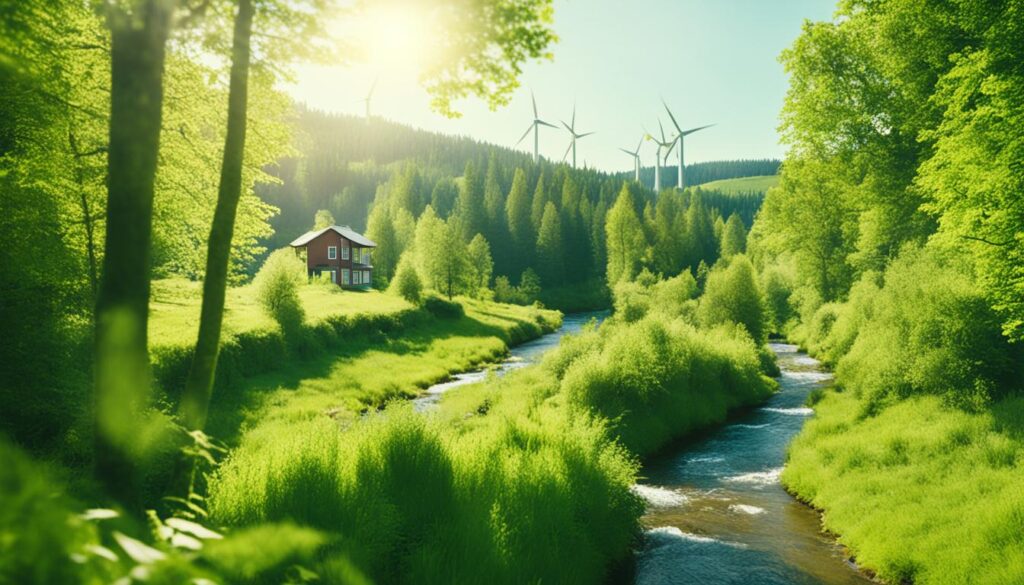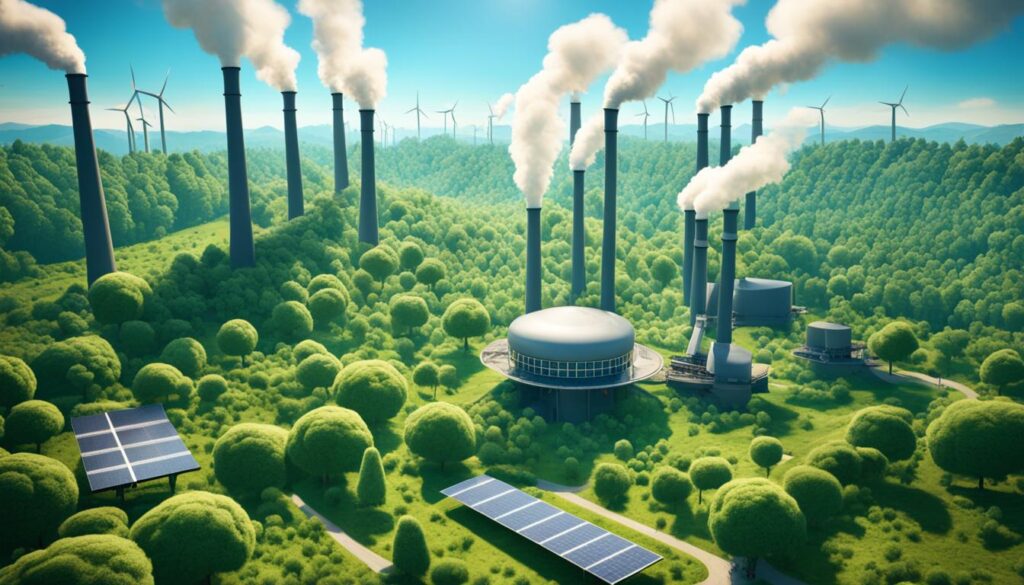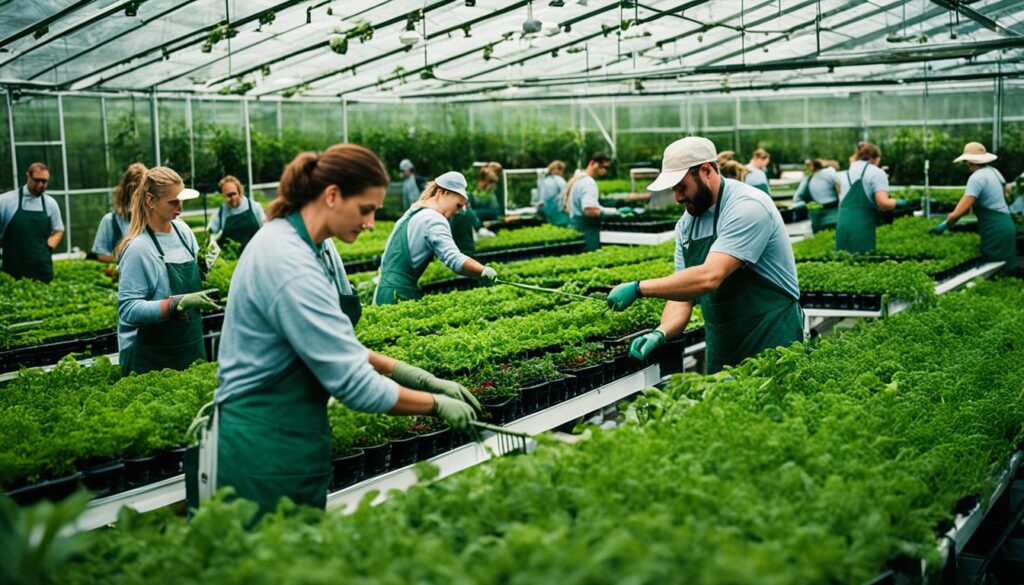In today’s world, we often worry about not having enough and harming our planet. A new idea is growing. What if we use the amazing power of plants to build a future that’s good for both us and the Earth?
Plant Power Pays Off: Unlocking Nature’s Abundance explores this exciting thought. Can we really bring out the best from nature?
And use it to make a world where everyone thrives while protecting our environment? Let’s explore and see what we find.
Key Takeaways
- Harnessing the power of plants can transition us away from fossil fuels and embrace nature’s abundance.
- The concept of abundance should replace the more limited goal of sustainability to drive exponential technologies and corporate involvement.
- Renewable energy sustainable agriculture, biofuels, and carbon sequestration are just a few of the ways plant power can deliver a sustainable future.
- Eco-friendly practices in business, green technology innovations, and eco friendly investments are unlocking new opportunities.
- Building a plant-based economy and the collaborative role of corporations and governments are crucial in driving sustainability.
Abundance The New Sustainability
Sustainability is known to all in the green world, but we must aim higher. Our world faces big issues, like climate change and ecological harm. So, we need to work towards abundance, where we can have a lot of good things, not just get by.
This idea comes from the huge potential of new technologies. These can lead us to a thriving world. Here everyone could live well.
Redefining Sustainability Goals
While sustainability is key, it’s not enough anymore. The time has come to jump into a new way of thinking. We should look to abundance, which is much more than just keeping things as they are.
By using exponential technologies like clean energy and AI, we can make big changes. These techs can help us find new ways to improve life for all.
Exponential Technologies for Abundance
New techs like renewable energy and smart farming are showing us a better future. They can meet the needs of a growing world. A good example is the $1.5 million grand prize won by the Skysource/Skywater Alliance. They developed a water maker that’s cheap and efficient.
This shows how these technologies can make a real difference.
Corporations’ Role in Driving Abundance
Corporations play a big part in this new era of abundance. They have the power and the money to bring big changes. Many are now focusing on making the world better while also finding new business chances.
For example, Adidas is making a lot of money from shoes made of ocean plastic. McDonald’s is also doing a lot of good by buying millions of eggs from cage-free chickens. Businesses are really pushing for a future where we have more and waste less.

The Current State of Scarcity
We are moving toward a world where sustainability is key. It’s important to look at the hard truths of our current system. Almost 66% of new global wealth since 2020 has gone to the top 1%. This shows a severe economic injustice.
Many struggle to buy basic goods while a few get richer. This shows the deep wealth concentration issue in our world.
We also face big challenges from using too many resources. Our planet is in danger, and we can’t keep going like this. Our actions threaten life on Earth and harm our future. We need to change, and fast. This change will have to come from all of us.

It’s time to face scarcity’s issues, both in how resources are shared and its impact on nature. A better future is possible if we change how we think about and use our resources. With a different approach, we can make a world where everyone thrives.
Plant Power Pays Off
Plants are becoming key players in our move to a sustainable future. They offer solutions for renewable energy sustainable farming, and cutting down carbon. This makes everyone from scientists to leaders to people trying to do their bit for the planet pay attention.
Renewable Energy from Plants
Plants are helping out big time in the clean energy field. With cool tech like turning plants into energy, we are starting to use what nature has given us. This move from using fossil fuels to plant power is a big step towards a cleaner world.
Sustainable Agriculture and Biofuels
Using plants smartly is making farming kinder to the earth. By working with plant cycles, farmers are growing food and fuel in a way that’s good for the planet. This not only makes farming less harmful but also brings new ways to make money.
Carbon Sequestration through Plants
Plants are fighting climate change by soaking up carbon. They take carbon out of the air during photosynthesis. It means planting more trees and using crops that trap carbon can help battle climate change and make our world better.
Eco Friendly Practices for Abundance
Businesses today are exploring ways to be more eco-friendly. They’re focusing on sustainable solutions and green technology. These efforts help the planet and create new chances for success.
Sustainable Solutions in Business
Companies are switching to solar and wind power to lower their carbon footprint. They also use circular economy models to cut down on waste. This way, they make the most of resources and keep them out of landfills.
Another trend is working closely with local farmers to get ingredients. This both supports the local community and lessens the impact of transporting goods long distances. It follows the ideas of eco-friendly practices.
Green Technology Innovations
Businesses are increasingly turning to green technology for a sustainable future. They’re using water-saving appliances, electric vehicles, and smart building systems. These technologies are changing our lives and workplaces for the better.
In construction, using sustainable solutions has cut costs through material recycling. Plus, with remote work growing, there’s less energy use and emissions. This benefits the planet, saves money, and gives flexibility to workers.

Investing in Eco Friendly Technologies
The world is moving towards a more sustainable future. This makes investments in eco-friendly technologies very important. More investors are looking into models that focus on both financial gains and making a positive impact. They see the value in eco-friendly investments for the long run and for changing industries.
Eco Friendly Investments and ROI
There was a big jump in green technology investments to $755 billion in 2021, up 25%. This shows a clear interest in green and sustainable options. Renwable energy got $368 billion, the most. Green transportation also did well, hitting $273 billion, up 77% from the year before.
Plant-Derived Products for Sustainability
In addition, the market for plant-derived products is growing. These products, based on nature, are being used a lot now. They are used for energy, biofuels, and in making eco-friendly products and packaging. This growing area offers lots of chances for investors wanting to support the environment.

Reducing Environmental Impact
We are facing a big challenge with climate change. It’s crucial that we lessen our environmental harm. Thanks to the rise of alternative fuels and bioenergy there’s hope. These new energy sources can help lower our carbon footprint. They offer a way to move towards a cleaner future.
Alternative Fuels and Bioenergy
Alternative fuels, like biofuels made from plants, have a big role to play. They can take the place of fossil fuels in many ways. Whether it’s in our cars, making electricity, or in factories, they can help us use fewer harmful resources. It’s important to improve how we turn plants into fuel. This helps make using bioenergy more effective.
Clean Energy Transition
Today, the world is turning more and more to clean energy. Solar, wind, and water power are becoming more popular. The goal is for 90 percent of the electricity we use to be from these sources by 2050. This change is not just good for the environment it’s also creating new jobs. By 2030, millions of new green jobs could be out there.
Carbon Footprint Reduction Strategies
We must work on this problem from many angles. This means finding ways to use energy more efficiently. We should also choose products and ways of living that are good for the planet. And, let’s not waste things. Instead, aim to use everything more than once. If we do all this, we can help make our Earth cleaner and protect its natural balance.

| Metric | Value |
|---|---|
| Fossil Fuel Greenhouse Gas Emissions | Over 75% of global total |
| Global Renewable Electricity Production | About 29% |
| IRENA Renewable Electricity Target by 2050 | 90% |
| Potential Renewable Electricity by 2030 | 65% of global total |
| Projected Net Gain in Clean Energy Jobs by 2030 | 9 million |
Building a Plant-Based Economy
The world is waking up to the power of plants. An economy centered around them is starting to grow. This new way of thinking uses plants in everything, spurring sustainable growth and taking better care of our planet.
Biomass Conversion and Biofuel Production
The heart of this movement is advanced biomass conversion. It turns plant materials into biofuels that can power our world. This switch from fossil fuels to plant fuels is both smart and good for the Earth.
Green Energy Solutions from Plants
The plant-based economy isn’t just about biofuels. It’s also about finding other ways plants can give us energy. This includes growing special crops for power and using plants in green buildings. The possibilities for clean, plant-based energy are endless.
More and more people are pushing for a sustainable world. The plant-based economy offers a way forward, showing that we can do well by the planet. It paints a future where both our economy and the Earth thrive, by making the most of what plants offer.

The Role of Corporations and Governments
The need for sustainability is pressing, and both corporations and governments are key players. Governments set eco-friendly regulations and offer eco-friendly incentives to push corporations towards sustainability.
Public and private partnerships can stimulate new, sustainable ideas and speed up our move to a sustainable future.
Eco-Friendly Regulations and Incentives
Tough eco-friendly regulations are a force for change. They make companies reconsider how they do things, urging them to put the planet first.
By introducing things like carbon pricing and bans on non-recyclables, governments encourage big investments in green tech and eco-friendly practices. Plus, eco-friendly incentives, like tax breaks and subsidies, make choosing sustainability even more attractive for businesses.
Public Private Partnerships for Sustainability
When the public and private sectors join forces, amazing things can happen. Public-private partnerships allow governments and companies to pool their know-how and resources. This leads to creative ways to tackle big environmental issues.
Through these partnerships, progress in clean energy, green farming, and smart waste management can happen quicker. This effort drives sustainable change on a grand scale.
| Key Factors | Importance |
|---|---|
| Eco-friendly regulations | Compel corporations to prioritize sustainability and invest in green technologies. |
| Eco-friendly incentives | Encourage corporate adoption of sustainable practices through financial and policy support. |
| Public-private partnerships | Foster innovative solutions and accelerate the transition towards a more sustainable future. |
Conclusion
Our journey through plant power shows how vital nature is. By using what nature gives us, we can build a better future. The change from seeing just sustainability to the wider abundance vision is key.
With exponential technologies and teaming up across sectors, we tap into plant-based economy power. This way, we boost renewable energy and eco-friendly farming. We also push for new green tech and ways to trap carbon.
Plant power will play a big role in making our world better. We can create a future that’s prosperous for everyone. It joins caring for our planet with growing our economies, making our society healthy and strong.





